Symi Island Greece Travel Guide 2024
Looking for the Latest Travel Guide to Symi Island in Greece?
Symi (aka Simi) is an enchanting island in the Dodecanese island group in the eastern Aegean Sea in Greece. Colourful villages, outstanding beaches, clear water, history and mouth-watering Greek cuisine will tempt all your senses.
We have developed a travel guide to Symi with up to date prices and activities. Symi is its own small piece of paradise. How long should you spend in Symi – 1 day, 2-3 days or more? Follow our guide and make your choice. Some come for an extended holiday. We travelled here in 2022 and have updated the information to 2024.
When is the best time to visit Symi? Agreeable weather from April to November but the best time is May-June and September-October (as we did).
Best Things to do in Symi
Walk the Harbour at Gialos
Symi Town (Gialos) is the largest settlement on the island. Its population is clustered around the main harbour and surrounding hills.
Symi town is divided into two parts – upper and lower. The lower is called Gialos; the upper original settlement is called Chorio or Ano Symi
There’s only one way to explore the main thoroughfare along the harbour. Walk it leisurely and explore.
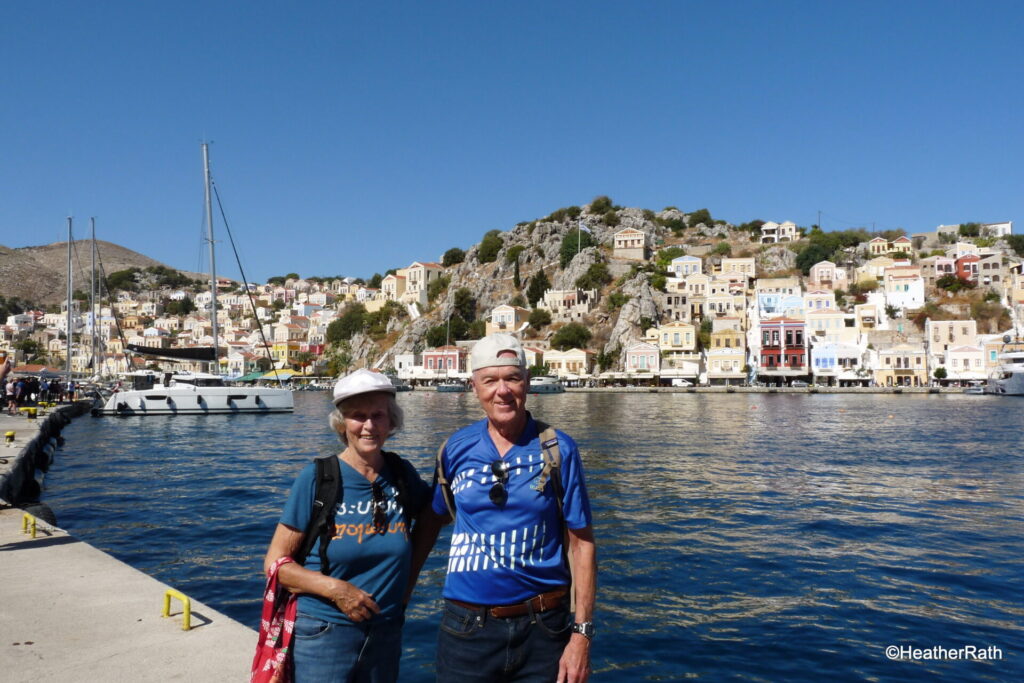
Harbour Landmarks
Look for bell towers on the right and left in the harbour. The continuous running clock tower (Roloi) was built in 1881.
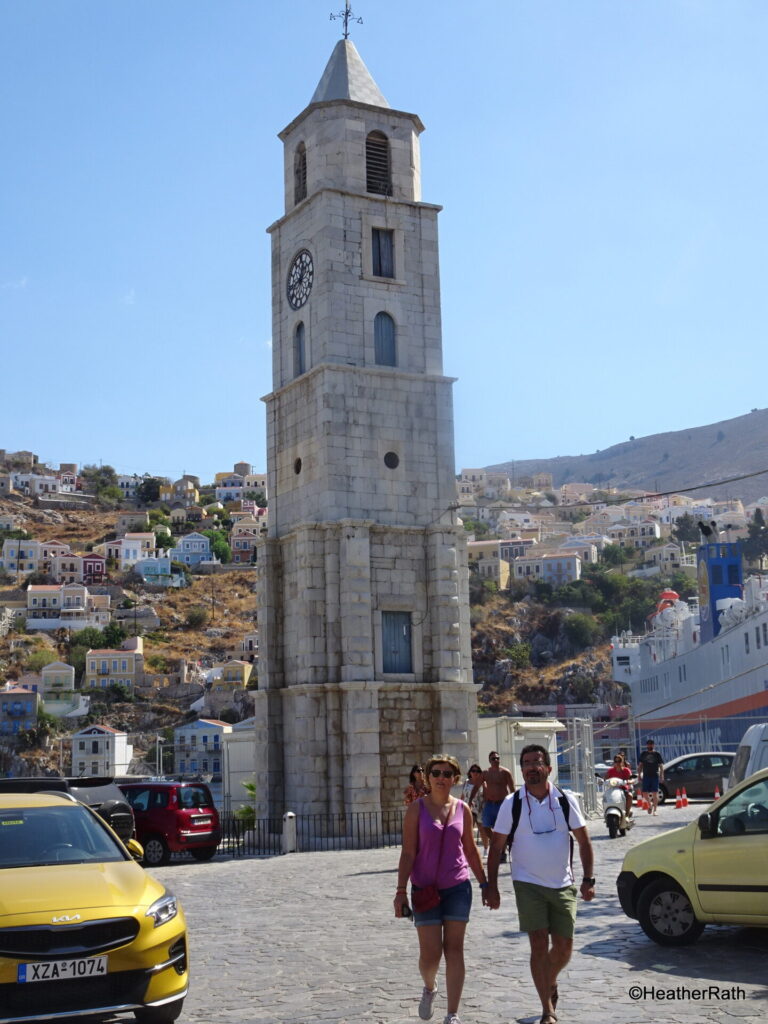
On the right side is the bell tower of Evangelistria, standing like a sentinel on guard. Its position hides the neo-classical architecture mansions of Gialos. Farther along is the Nautical Club of Symi with its sandy beach.
Walking back into harbour town from this farthest point brings you to the modern hotels of Aliki and Nireus (both former hostels) where many Symiots and visitors gather for coffee. And sometimes dip into the sea off accommodating docks.
In front of the Roloi, look for Michalaki, the Little Fisherman sculpture, who welcomes seafaring vessels into the harbour.
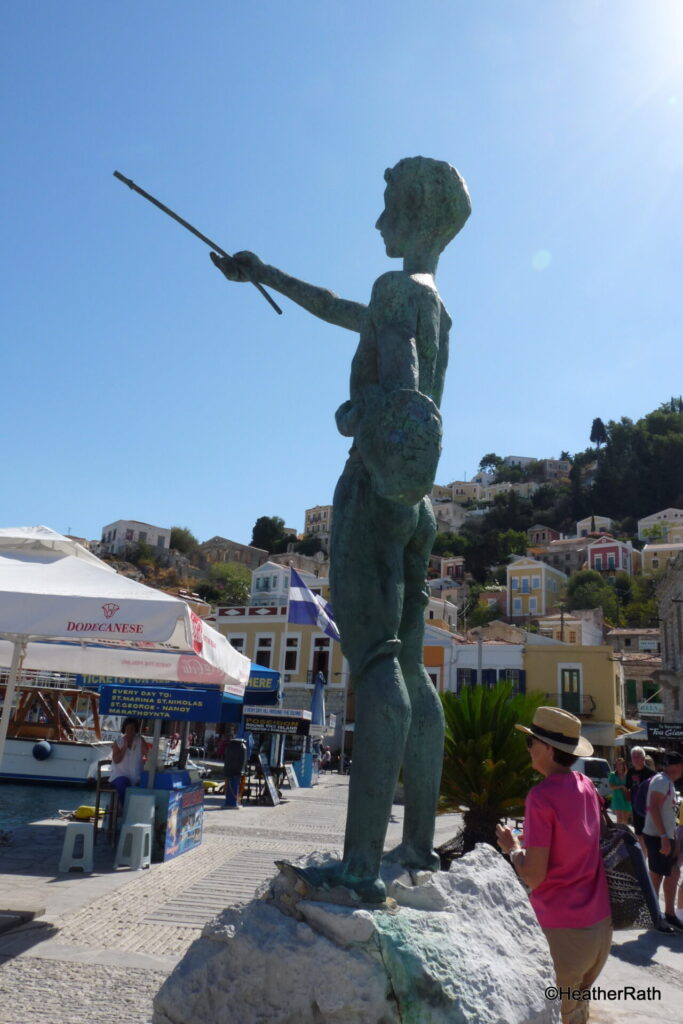
Next to the Roloi you will find the island police in a building showing remnants of the architecture from the years of the Italian Occupation.
Following on is the House of Kampsopoulou where inscribed on its front is this reminder: “The surrender of the Dodecanese to the allies was signed in this building on the 8th of May 1945.”
Don’t miss the sculpture of the Sponge Diver close to the bridge at the harbour. Stathis G. Hatzis (1878-1936) was the head diver among Symi’s and the Dodecanese’s hundreds of free divers – sponge divers in the early 20th century. In 1913, he free dove to a depth of 88 meters, for 4 minutes, in his attempt to locate and tie the anchor of the Italian battleship Regina Margherita which had been lost on the ocean floor. There’s more to this story. But you can read it at the sculpture when you visit.
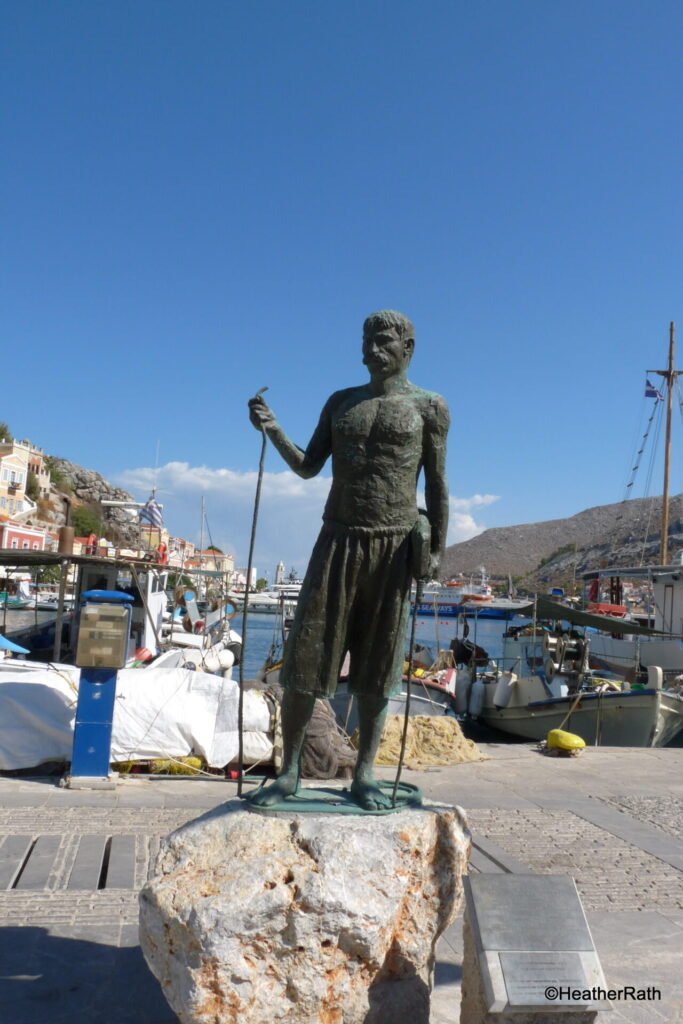
Climb 500 Steps to a Castle
There are 500 steps from the port to the ruins of a castle built by the Knights Hospitaller of St John. Most take a bus almost to the top. We did meet one couple from New York who climbed those steps. A taxi is another choice. The bus is hourly.
The 500 steps we chose to ignore are the celebrated ‘Kali Strata’, built by rich Symi merchants in the 19th century to link the old upper village, Chorio, with the new mercantile area of Gialos in the harbour.
The old route, the Kataraktis, was a donkey path running up the side of a cataract at the back of the harbour, leading to the Kastro (castle) and very oldest part of Chorio.
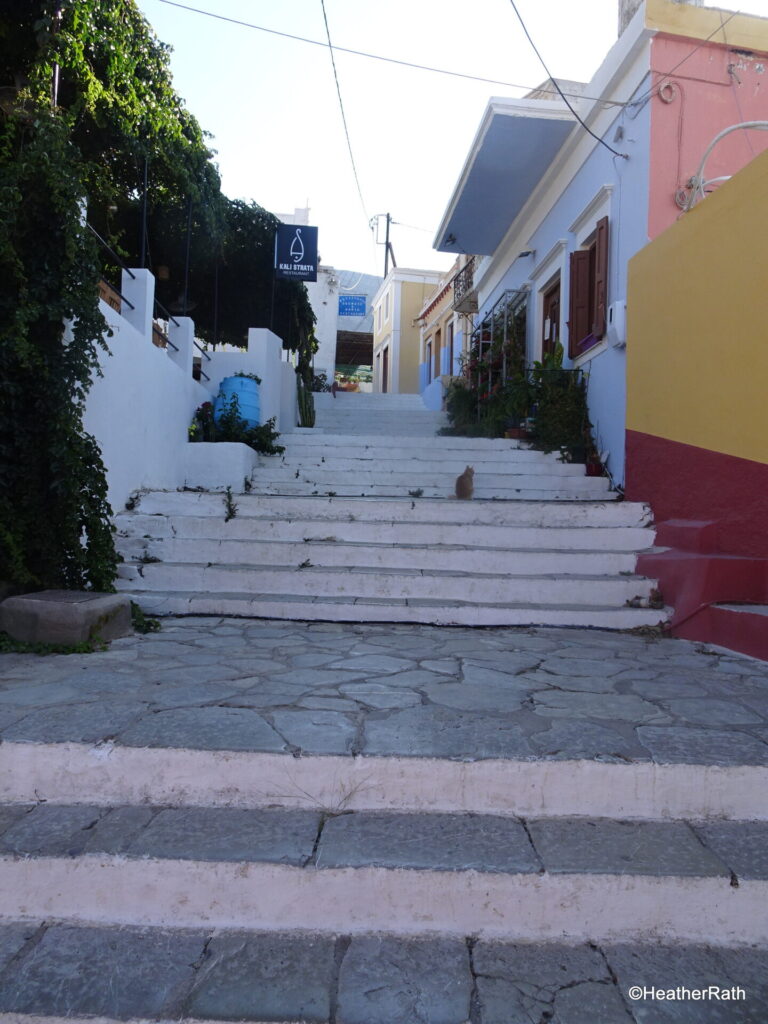
Venetian Castle Ruins
This Venetian Castle was built by the Knights Hospitaller in 1407. It was built in part with the remains of an ancient acropolis from 5th century BCE. On this location once stood a temple to Athena. The castle ruins incorporate blocks within its walls from Megali Panagia Church (see next item) and the ancient acropolis.
The castle was destroyed by the Germans in WWII as was the adjacent church. It was built atop the ruins of an old Byzantine Castle, with an incredible hilltop location. Overlooking the terracotta roofs of the town and the deep turquoise Aegean Sea, this is a wonderful place to admire the beauty of the island.
The view of the harbour from the ruins is worth a photo.
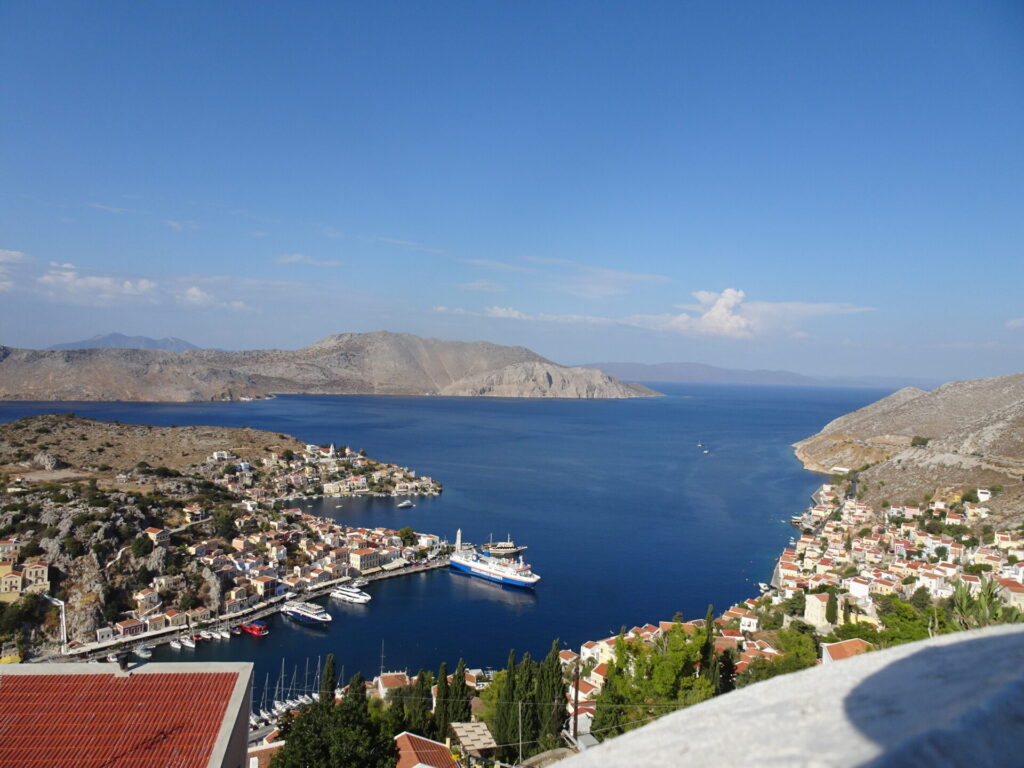
Megali Panagia Church
White with blue trim, the iconic Greek colours, Megali Panagia church sits close to the destroyed castle atop the hill overlooking Symi Harbour.
As mentioned, this church was also destroyed in WWII. The church was originally dedicated to Aghios Giorgios, but it took the name of the original Panagia church to the south after being rebuilt.
Symi archeological museum
The Symi archeological museum is in Chorio, the upper village.
Once a family home, the restored building/museum focuses on three areas: archaeology, Byzantine selection, and a folklore collection.
The archaeological portion includes findings from excavations held on the island; the Byzantine area features Byzantine and post-Byzantine icons, coins and musical manuscripts.
The folklore collection is richer in interest than the former two showing traditional costumes, musical instruments, hand-woven materials, tools of everyday life, and early life photos.
Admission: about 4 euros. Temporarily closures occur so check hours before climbing steps or hills to see it!
Windmills
Harnessing the wind for energy with windmills is part of Symi’s history. To view them upclose and personal, we suggest a walking tour to see some of these 16 circular historical icons on the island.
The walk is 6.8-km loop trail that begins in the harbour. Uphill and down, but considered an easy route, it takes an average of 2 hours plus to complete. Check with Symi Travel located at the beginning of Symi’s central harbour road for more information.
Some refurbished windmills are available for rental as accommodation, considered an unique experience. Unfortunately, many of the windmills are still in disrepair.
Stone Wine Presses
What is life without wine?
More than 130 abandoned stone wine presses can be found on Symi. The ‘Byzantine’ wine presses, as they are known locally, are mostly located in the cypress forests in the southern lowlands.
After shipbuilding, sponge fishing and trading, viniculture was a thriving industry during the Byzantine era. Symi Island Greece was especially famous for its excellent white wine. The circular stone wine presses today are the remnants of that time.
Take the road from the town to Panormitis Monastery. Watch for a sign on the left of the Monastery of Megalos Sotiras. Follow the path through a cypress forest to the wine presses.
Monastery Roukouniotis
A castle-like monastery, visible on the way from the harbour town of Gialos to Chorio, is famous for the patriarchal cross once placed into the foundation. Built in the 15th century by the Knights Hospitaller.
Formidable wall paintings of the 15th century are found in the old lower church; others dated later in 1738 are on view in the new upper church. Don’t miss the 100 year old cypress tree by the monks’ cells.
It is about 5 km from town off the road to Chorio. Best to take a taxi or a rental car (get directions).
Monastery Panormitis
It appears an ancient temple ‘might’ have existed here. Following an early Christian church (perhaps in the 6th century) a monastery may have formed here in the 9th century. The first real evidence of the monastery was not until the 15th century. A manuscript from here dates to 1460. Michael Panormitis built a 5th monastery here for the Archangel Michael 1753. This is what we see today, greatly restored. Archangel Michael is the Patron Saint and protector of Symi and of sailors. There is a bus from Gialos which takes about an hour to cover the 19km roads with many switchbacks.
The monastery includes two museums in its yard. The first has mainly religious icons and items. The second displays an exhibition of folk culture, including items relevant to fishing, agriculture and shepherding.
Fun Fact: During the summer, tourists can rent some of the cells (monk’s quarters) for a modest sum.
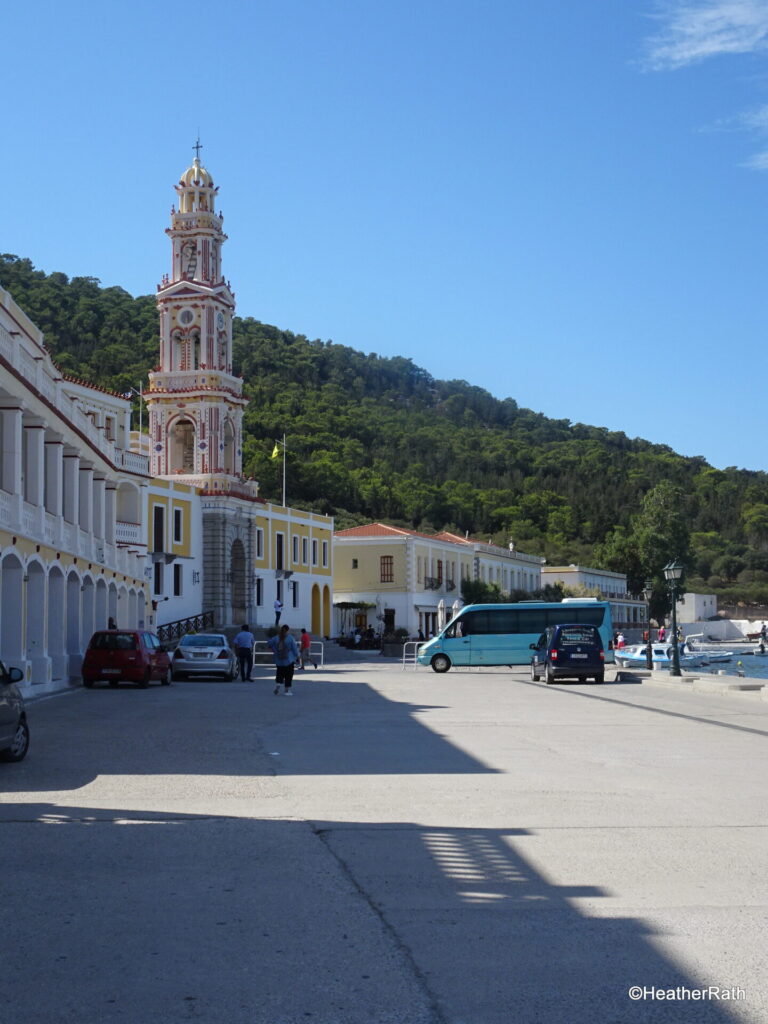
Beaches
Beaches on a rocky island? You bet, 16 in fact. Sandy? Naw, but it’s okay. Most of Symi’s popular (but pebbly) beaches offer chaise lounges and umbrellas for rent. Many have tavernas serving food and beverage. Each beach kisses the crystal clear cold clean waters of the Aegean Sea. See the locations on the map below
Like a Greek mythical god and goddess, dip your toes (and body!) into one of these spots:
Nos – stands for Nautical Club of Symi. The closest (and only sandy) beach to the harbour. A 15 minute stroll past the clock tower. Easiest to enjoy. Refreshments available.
Saint George Bay Beach – Reached only by water: boat/kayak. Beach is rocky (more than pebbly) but water is beautiful. Considered the most famous in Symi. Temperature: cold. Colour: turquoise
Nanou Beach – can be reached by hiking. Most come by water. Similar to Saint George.
Pedi – most touristy because of small hotels set back on the road. Umbrellas, sun beds available. Reachable by bus.
Panormitis Beach – If you’re taking the bus from the harbour, or renting a car to drive to the Archangel Michael Panormitis monastery, your overheated body may appreciate cooling off at this beach.
Other beaches – you need to hike/walk a short distance — worth checking out are: Nimborio/Emborios and Gialos,
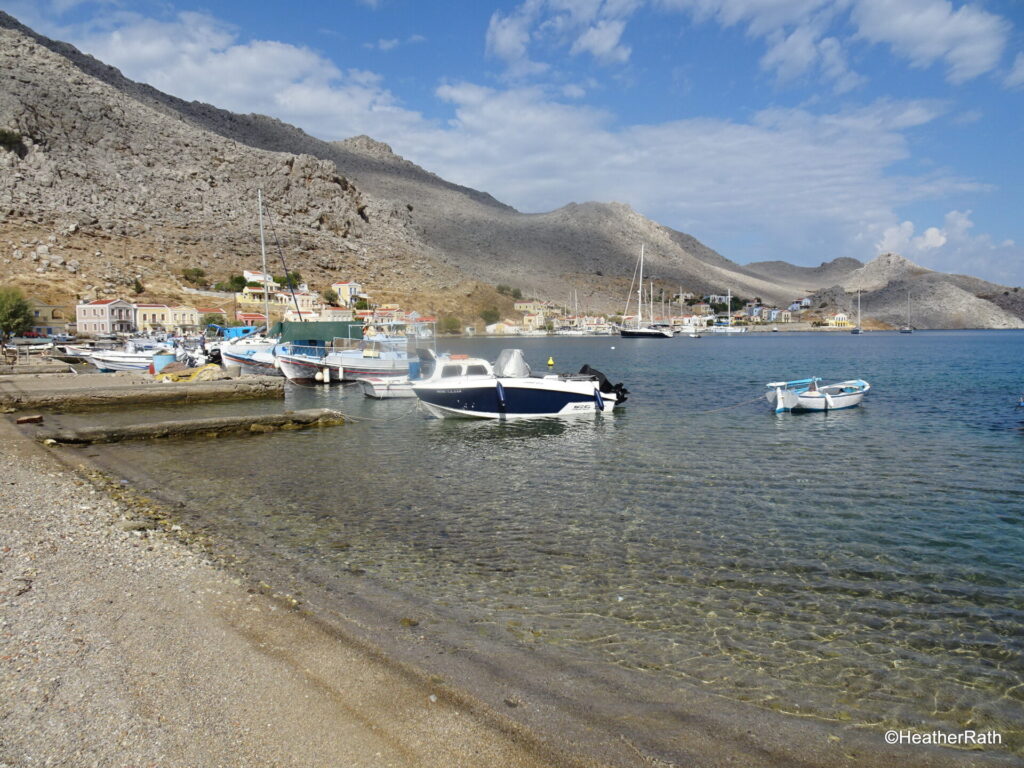
Boat Cruises/snorkelling/diving
Many options are available for boat cruising around Symi, both from Rhodes and around the harbour at Symi. Check out what you want because whatever you want is available.
Most boat trips include stops at Symi beaches for snorkelling.
Likewise scuba diving with PADI qualified professional divers is popular and available at shops around Symi harbour.
Picturesque Villages of Symi
Everyday life of a Symiot is best seen (but please don’t interfere with) by wandering/exploring some of the small villages. How do the people live?
Panormitis (outside the monastery) infuses the visitor with a great sense of peace.
Pedi is a small fishing village located in a bay east of Gialos, just below Chorio. The third largest village on Symi, it attracts tourists for its narrow gravel beach, tavernas, and pensions. Many visitors relish its peace and quiet away from the maddening crowds. Easily reachable by bus.
Nimporios/Empario
3 km northwest of Gialos, can be reached by car. Once a thriving commercial site, these days it’s famed as one of the most picturesque fishing settlements in Symi with an attractive pebbled beach and wonderful views across the bay.
Get lost
That’s what we did! – in the labyrinth of streets above the harbour
The high, stone-walled streets are like a maze. Just when you think you know where you are, you aren’t. If you pinpoint a landmark, you can usually find your way.
However, if you get lost, no worries. The townspeople are friendly, accommodating, and easily steer you in the right direction. To the bus stop!
History of Symi
Symi Island dates back to ancient times and is mentioned in the Iliad of Homer for its role in the Trojan War, as it was headed by the Symian King Nireus. In addition, Herodotus referred to Symi as a member of the Dorian Hexapolis, meaning 6 cities. In fact, since 480 B.C. Symi belonged to the Athenian League. In the Roman and Byzantine periods, Symi was aligned with Rhodes as it is today.
The name comes from the nymph Symi, who married Poseidon, the god of the sea, and gave birth to the later leader of the island’s inhabitants.
In 1309 it was taken over by the Knights Hospitaller. Conquered by Turkey in 1522 it became part of the Ottoman empire. During WWI it was invaded and occupied by the Italians. Bombed by the Germans in WWII. It was handed to Greece by the British Military in 1947.
Book your Symi Island tours by clicking here
How to Get to Symi
The only way to get to Symi is by water – ferry, private charter boat or your own yacht/sailboat.
For most travelers the ferries from Rhodes are best. There is an overnight ferry from Athens.
Blue Star Ferries, Dodekanisos Seaways and Sea Dreams are popular ferry operators offering high speed ferries to Symi from Rhodes. Tickets can be purchased at the ferry terminal, Kolona or Akandia and along the facing street. It is easier to purchase tickets online at https://www.ferryscanner.com/en/ferry https://www.ferryhopper.com/en, https://www.ferryconnection.com
Ferries take 1hr to 1hr 20 min and cost 10-20 euros. It is possible to travel to Symi and back on the same day if your time is short . We recommend at least 2 – 3 days to better experience Symi.
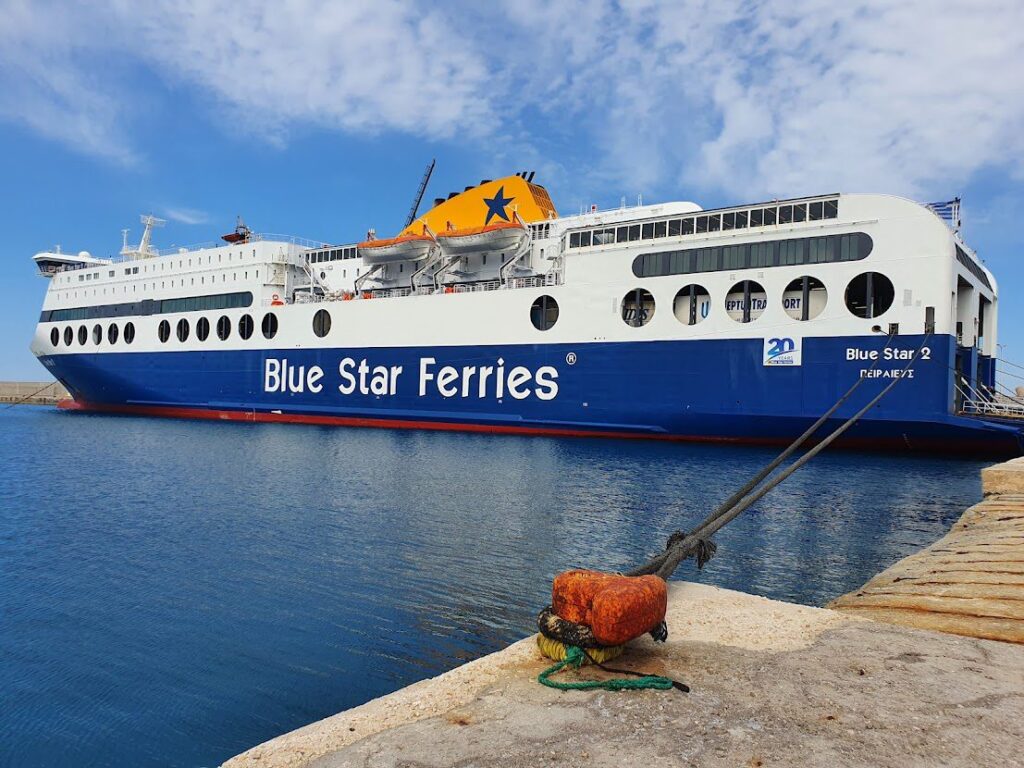
Map
Symi Island is located in the eastern Aegean Sea less than 5 miles (7km) off the coast of Turkey and about an hour ferry ride from its closest big neighbour, Rhodes.
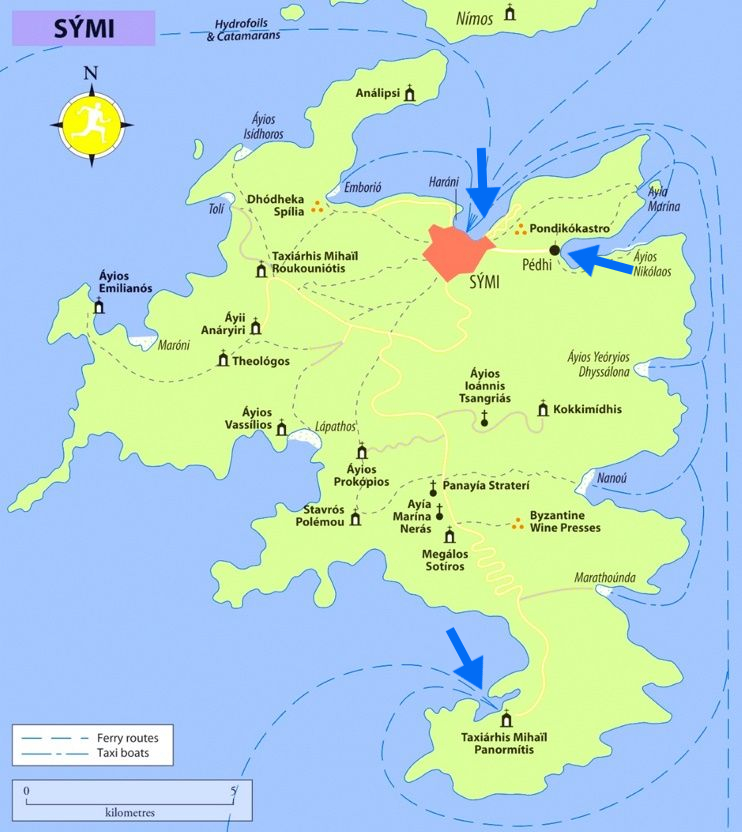
Where and What to Eat
Naturally, seafood is a specialty. Fresh from the sea. Beautifully prepared and presented.
Try the island specialties: fresh calamari and the famous local simiako garidaki – fried tiny shrimp – one eats the entire shimp, tails and all – no peeling!
For those who are meat lovers, Symi offers goat meat roasted in the oven or cooked within clay pots along with rice, orzo or spaghetti. Chicken and lamb, pork and beef, you name it. Traditional recipes are used.
There are many restaurants around the harbour, most of which are reasonably priced with good food. We always head for restaurants which are busy and pass by those which are not.
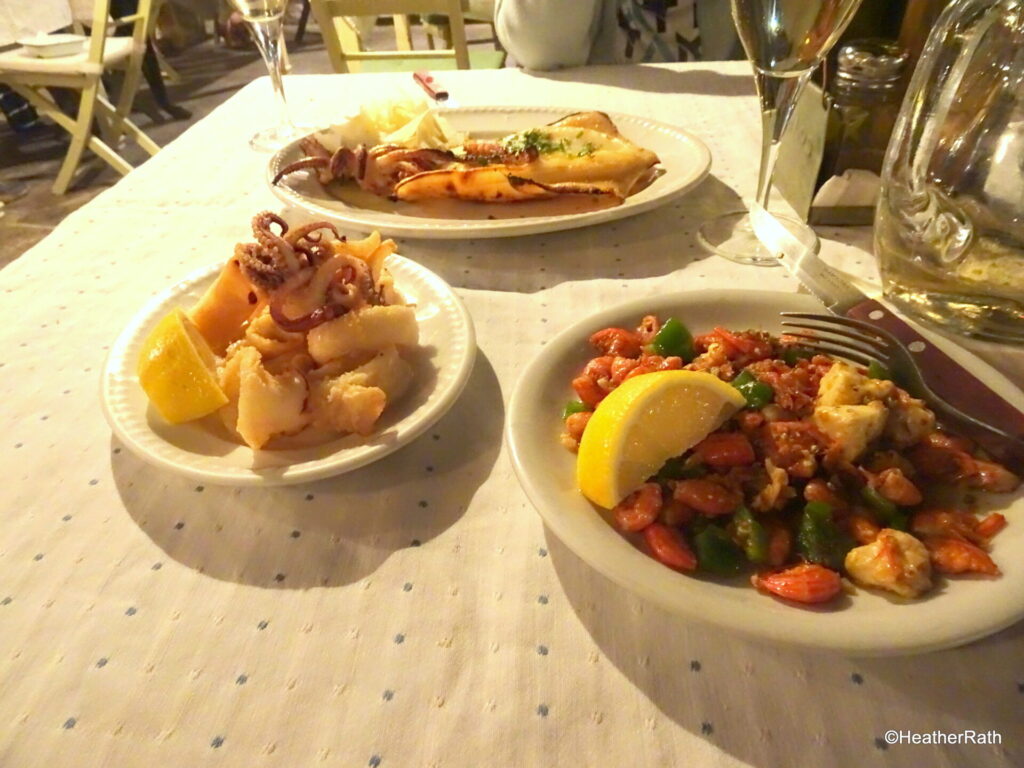
We can recommend Tholos Restaurant on the Harani side of the port.
The Secret Garden gets consistently good reviews – above the harbour with great view.
For lunch we recommend the restaurant at the Nireus Hotel, just past the clock tower
Around the harbour try
Taverna Zoe
Meet the Meat
Mano’s Fish Restaurant
Odyssia Restaurant
Where to Stay
Of course as with most tourist destinations there are multiple accommodation choices – hostels, B & Bs, private homes/apartments and hotels from budget to luxury. Most hotels include breakfast
Our recommendation – Nireus Hotel – just past the Clock Tower with water access for swimmers, reasonable rates including breakfast
Other hotels include (all under $100 USD/night)
Symi Garden Studios
Symi Center
Niriides Hotel and Apartments
Dorian Hotel
Maravelia’s Rooms
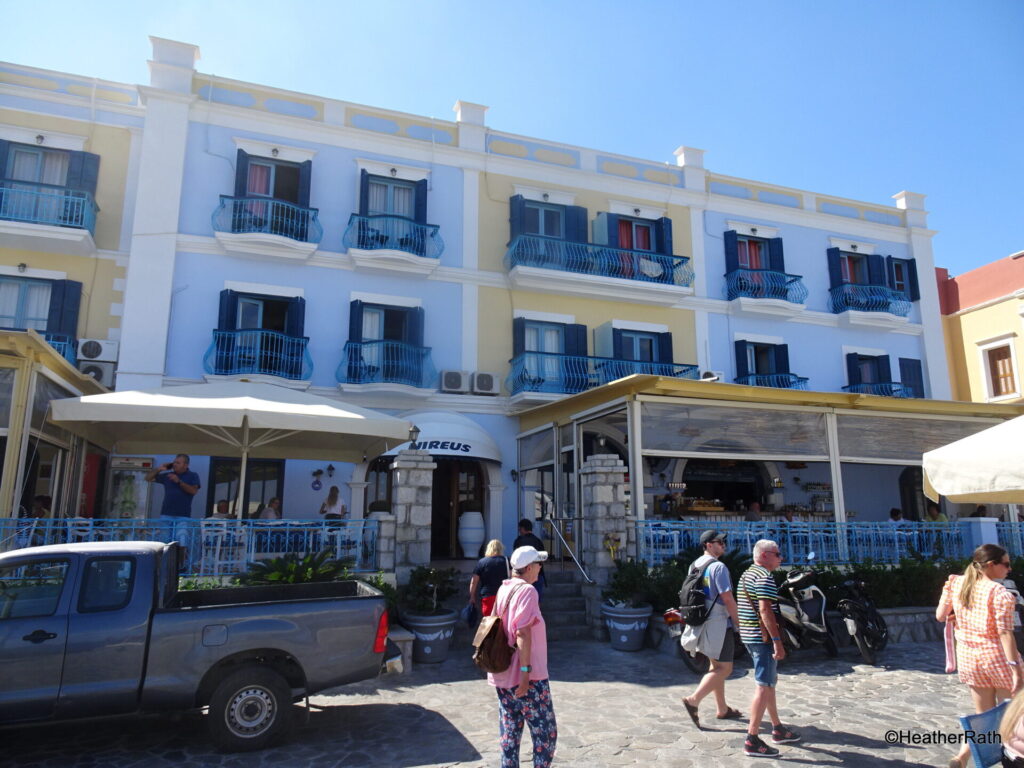
Book your Symi Island stay by clicking here
What to Buy
Symi is famous for natural local sponges. They can be found in shops around the harbour. Beware of synthetic sponges. Sponges are natural loofahs from the sea.
Simian salt is another local product.
Local stores sell many products from other Greek Islands – olive wood utensils, Raki liquor, ouzo, olive oil, wine, herbs and spices.
Of course many artisan ceramics, sculptures, paintings, jewelry and clothing are also available.
The Wrap Up
Once known primarily for its sponge divers, sponge trade and ship-building, Symi has graduated to the go-to haven for those who like to travel off the beaten track but still enjoy modern amenities. Explore soon before it loses its unique character.
This is a complete and up-to-date travel guide to Symi Island Greece.
Symi will steal your heart with its colourful harbour and historical sites.
Sights and Sounds of Symi
More Blogs from Greece
Read more of our blogs from Greece
Be a Guest Blogger
We welcome guest bloggers – contact us here with the tag ‘blogger’.
Affiliate Links
This post may have affiliate links, which means we may receive a small commission (at no extra cost to you!) if you choose to purchase through them. Here’s our privacy policy for more info.
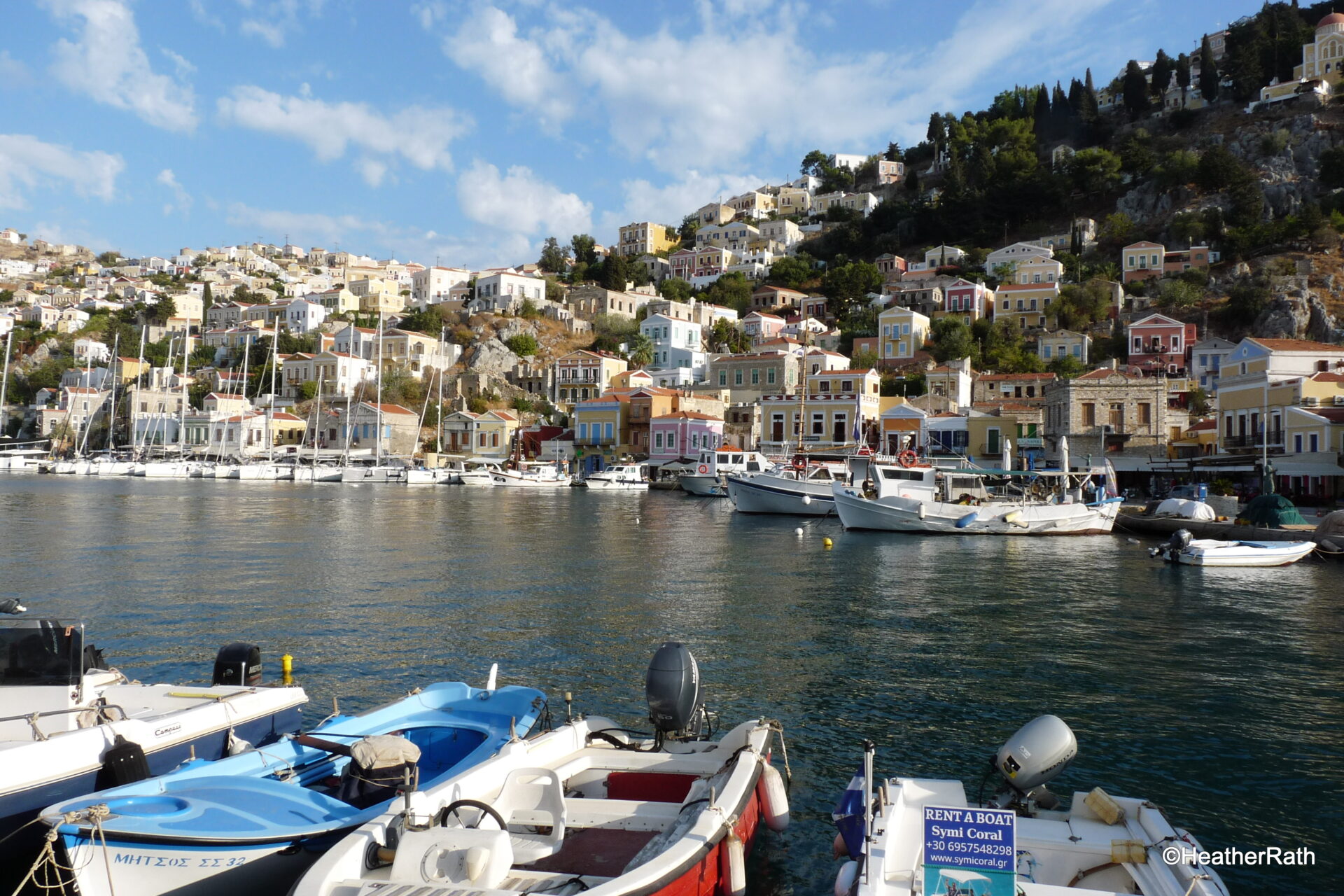
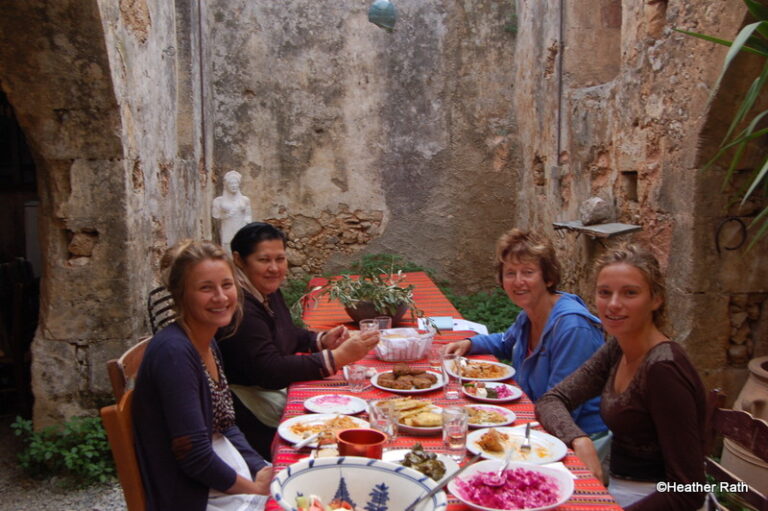
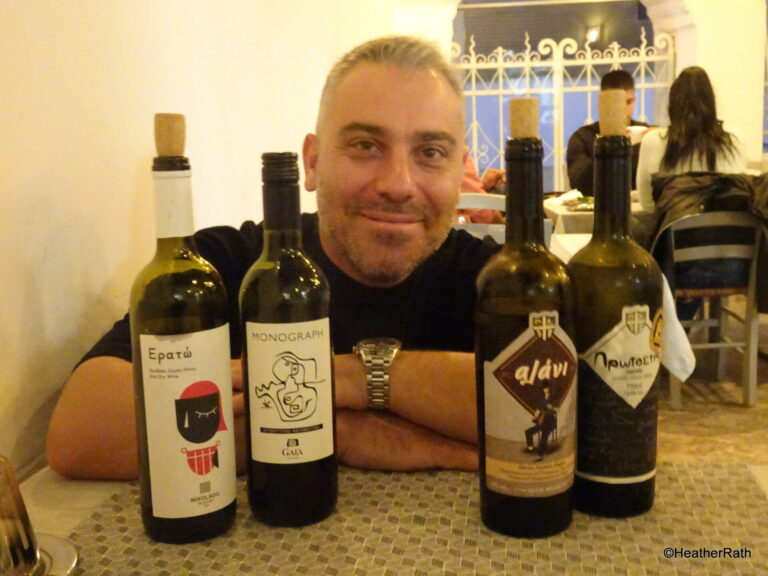
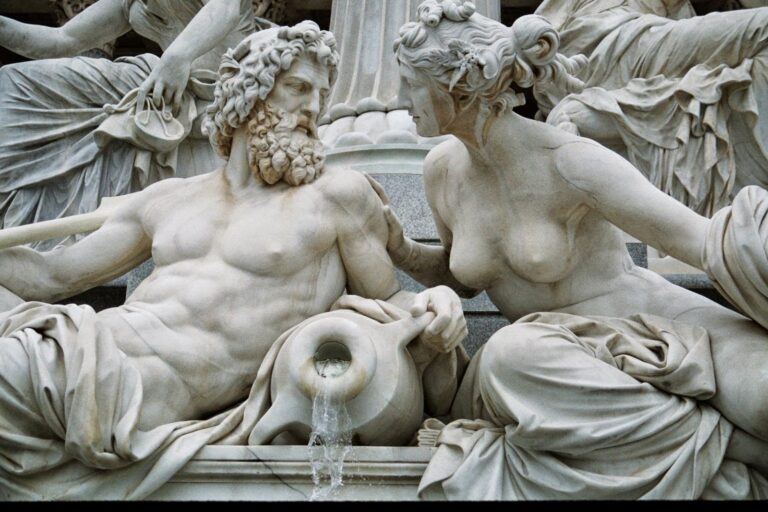
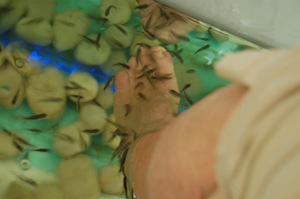
Hi — great information! But one correction, having come back from Symi just last month. The white steps you show in the para “Climb 500 Steps to a Castle” are not the steps you take — in fact the ones you illustrate are on the opposite side of the harbour and lead up to an overlook area featuring a large Greek national flag. The steps you need — called Kali Strata — are on the right-hand leg of the harbour (as you look out to sea from the centre of the harbour) and can be joined at a number of points all well indicated “Kastro”. It would be good to encourage your visitors to go up these steps (slowly!) because they are fronted by some of the most impressive and interesting houses on Symi, new and old. As for eating out, I’d put in a special shout for the excellent Taverna Neraida, just inland; and then on the Harani side, Taverna Kavos. Both had lots of Greek as well as other tourists eating there, always a good sign, and we had a couple of excellent meals, with friendly, warm, welcoming service at each. The Kavos is on the harbour walk to Harani and you can eat at tables set right up to the water’s edge, quite beautiful at night. We found Symi a wonderful place and your blog describes it extremely well and does it perfect service!
Hi John – thanks for your comments I have made the correction re Kali Strata. Your tips on eateries are great! Symi certainly is an island to love and experience.